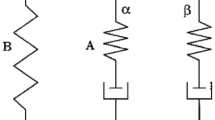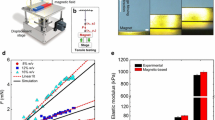Abstract
Mechanical strain triggers changes in inherent molecular structure, especially in polymeric and biological materials. Unlike conventional techniques, we demonstrate a novel dynamic mechanical characterization method to study the effect of this structural evolution with strain on elastic properties. During tensile characterization of small diameter fibers, we quantitatively measured the viscoelastic properties as a continuous function of strain. While this approach is useful to characterize the elastic properties of metal microwires independent of applied strain, it is extremely important for fundamental understanding of molecular changes and their effect on the viscoelastic properties in materials such as polymer fiber and spider silk.



Similar content being viewed by others
References
G. Khatibi, A. Betzwar-Kotas, V. GrÖGer, and B. Weiss: A study of the mechanical and fatigue properties of metallic microwires. Fatigue Fract. Eng. Mater. Struct. 28, 723–733 (2005).
F.D. Danaher, J.J. Williams, D.R.P. Singh, L. Jiang, and N. Chawla: Tensile and fatigue behavior of Al-1Si wire used in wire bonding. J. Electron. Mater. 40, 1422–1427 (2011).
Z. Ma, M. Kotaki, R. Inai, and S. Ramakrishna: Potential of nanofiber matrix as tissue-engineering scaffolds. Tissue Eng. 11, 101–109 (2005).
V. Leung and F. Ko: Biomedical applications of nanofibers. Polym. Adv. Technol. 22, 350–365 (2011).
C.Y. Hayashi, N.H. Shipley, and R.V. Lewis: Hypotheses that correlate the sequence, structure, and mechanical properties of spider silk proteins. Int. J. Biol. Macromol. 24, 271–275 (1999).
Z. Shao and F. Vollrath: Materials: surprising strength of silkworm silk. Nature 418, 741–741 (2002).
M.A. Meyers, P.-Y. Chen, A.Y.-M. Lin, and Y. Seki: Biological materials: structure and mechanical properties. Progr. Mater. Sci. 53, 1–206 (2008).
Y. Termonia: Molecular modeling of spider silk elasticity. Macromolecules 27, 7378–7381 (1994).
F. Vollrath: Strength and structure of spiders’ silks. Rev. Mol. Biotechnol. 74, 67–83 (2000).
E.P.S. Tan, S.Y. Ng, and C.T. Lim: Tensile testing of a single ultrafine polymeric fiber. Biomaterials 26, 1453–1456 (2005).
Z. Chen, B. Wei, X. Mo, C.T. Lim, S. Ramakrishna, and F. Cui: Mechanical properties of electrospun collagen–chitosan complex single fibers and membrane. Mater. Sci. Eng. C 29, 2428–2435 (2009).
C. Lechat, A.R. Bunsell, P. Davies, and A. Piant: Mechanical behaviour of polyethylene terephthalate & polyethylene naphthalate fibres under cyclic loading. J. Mater. Sci. 41, 1745 (2006).
J.M. Schultz Polymer Materials Science. Ch. 11 (Prentice-Hall, New Jersey, 1974).
S. Toki, T. Fujimaki, and M. Okuyama: Strain-induced crystallization of natural rubber as detected real-time by wide-angle X-ray diffraction technique. Polymer 41, 5423–5429 (2000).
S. Ran, D. Fang, X. Zong, B.S. Hsiao, B. Chu, and P.M. Cunniff: Structural changes during deformation of Kevlar fibers via on-line synchrotron SAXS/WAXD techniques. Polymer 42, 1601–1612 (2001).
G. Washer, T. Brooks, and R. Saulsberry: Characterization of Kevlar using Raman spectroscopy. J. Mater. Civil Eng. 21, 226–234 (2009).
S.W. Cranford, A. Tarakanova, N.M. Pugno, and M.J. Buehler: Nonlinear material behaviour of spider silk yields robust webs. Nature 482, 72–76 (2012).
W.C. Oliver and J.B. Pethica: method for continuous determination of the elastic stiffness of contact between two bodies. US Patent (1988).
J. Hay, P. Agee, and E. Herbert: Continuous stiffness measurement during instrumented indentation testing. Exp. Tech. 34, 86–94 (2010).
T.A. Blackledge and C.Y. Hayashi: Silken toolkits: biomechanics of silk fibers spun by the orb web spider Argiope argentata (Fabricius 1775). J. Exp. Biol. 209, 2452–2461 (2006).
Author information
Authors and Affiliations
Corresponding author
Rights and permissions
About this article
Cite this article
Basu, S., Hay, J.L., Swindeman, J.E. et al. Continuous dynamic analysis: evolution of elastic properties with strain. MRS Communications 4, 25–29 (2014). https://doi.org/10.1557/mrc.2013.49
Received:
Accepted:
Published:
Issue Date:
DOI: https://doi.org/10.1557/mrc.2013.49




